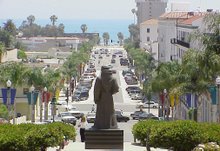Monday June 25, 2007 we participated in the City Council meeting. Our public art department representatives inspired a discussion about the achievements of our city’s public art program and admirable public art collection. After an outstanding presentation, Councilman Ed Summers spoke very highly of the public art department, public art projects and of our internship program. He brought up some important points worthy of reiterating.
- The importance of public art as a means of historically encapsulating our identity as a culture
- “Making our mark”, a means of visual communication
- The public art of today is the ancient artifact of tomorrow
Tuesday evening’s Public Art Commission meeting also stimulated conversation regarding the importance of public art. We had the opportunity to observe the proposals of the soon to come painted utility boxes. Local artists were selected to paint utility boxes along Main Street in the downtown during the summer artwalk on August 18, 2007.
The proposed pieces will surely contribute to the beautification of our city. Until one attends one of these meetings (they are open to the public), one may not have an authentic appreciation of the necessary and tedious processes involved in calling for, proposing, choosing, installing and conserving public art. It is a time consuming task to which only those who truly love their city and love art would care to contribute.
Our weekly Wednesday afternoon intern meeting offered further discussion regarding this week's reading and the importance of public art. Cultural Heritage Preservation, Sites of Hurtful Memory uses examples of places of horrible memories to exhibit the challenges some conservationists face when confronted with ethical questions regarding certain pieces of art and memorials. The type of proper conservation that should be done was argued from opposing perspectives. Some of the examples that were given are listed below:
- Hiroshima Peace Memorial Park
- Los Desaparecidos (the disappeared) at the Club Atletico in Buenos Aires, Argentina.
Topography of Terror, memorial in Berlin - Buildings at Auschwitz
So yes folks, you have it here. The signs were consistently pointing this week to the importance of public art. Whether we were out on the trail conserving mile markers, in city hall attending a meeting, or at the beach reading articles about ethical challenges that artists and conservationists face, the importance of public art is this, a way of “increasing people’s awareness of architectural assets in their community works to strengthen both social and cultural identity.”


